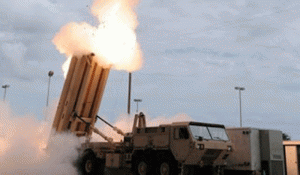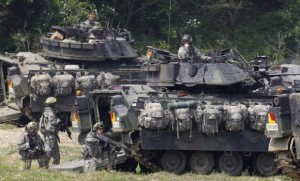2014-01-25 By Ed Timperlake
With North Korea now a nuclear power with evolving strike missile capabilities, the past is not prologue to the defense of South Korea.
The US Army is not simply a barrier force to the invasion from North Korea; it needs to be shaped as part of the joint force solution to maneuver warfare and the strike and defense enterprise.
Deterrence will rest on the ability to dismantle the offensive strike forces of North Korea and to pull apart its command structure. It is not about preparing for a new version of the battle of the Marne.
As the US Army considers its contribution moving forward it is less about the armored forces than about the mobile defense forces. It is less about the tank and more about the THAAD.
Recently, we published an interview with the THAAD commander on Guam and his treatment of the evolving role of Army Air Defense (ADA) provided a window into the evolving Army role. Lt. Col. Cochrane, the THADD Task Force commander who is currently based on Guam, provided insights into the efforts to shape a flexible, mobile defense force in front of the strike forces.
Missile defense is more than just one platform or system. It is a classic case of what you call no platform fights alone. It is a system of systems.
We combine Aegis, with THAAD with short-range defense systems, etc.
For example, at Hickam Air Force Base in Hawaii, the 94th AAMDC and the 613 AOC coordinate air and missile defense for the Pacific Theater. The Navy and the Air Force all come together and conduct that coordination in terms of how we protect and coordinate our defense so that we are maximizing our capabilities.
It is not just a single system standing alone or operating independently.
It is the inter-dependence and the inter-operability of all these systems to all three of the branches that are actively engaged in missile and air defense.
In my unit, we are looking aggressively at how to cross link with Aegis, for example.

This is suggestive of an evolving and significant role for ADA in Pacific defense.
One just has to look at the geography of the Pacific and ask why just Guam and does a THAAD Battery always have to be moved by truck?
The answer to this question is part of a larger question: how does Army missile defense play in the attack and defense enterprise within the strategic quadrangle?
With the significant capabilities, which the South Korean ground forces have put in place, the US Army can migrate to play a significant role in the attack and defense enterprise. If Big Army sends ADA it is recognition of the trust in the combat success of seven decades of capability building partnership with South Korea.
Sending ADA is very important, vice the expense of heavy lift on the USAF moving heavy armored US Army forces. THAAD on the other hand is a new and developing technology, and a strong signal of complete US command confidence in South Korean military capability.
The past is not prologue with regard to the place of South Korea in Pacific defense.
One of the best books ever written about lack of military preparedness was by a US Army officer who fought in the Korean War, the late T R Fehrenbach This Kind of War.
His book echoes to this day how badly equipped the South Korean forces were at the time when the US withdrew from Korea in 1949. The US Army had demobilized in 1949 and when the Korean war broke out a year later the South Koreans were not prepared for their own defense.
This is not the situation today. The ROK Army (ROKA)—the sixth largest army in the world—is by far the largest of the military branches, with 506,000 soldiers as of 2012 about same size as entire regular US Army. Currently, the US Army has about 28,500 troops in South Korea.
Given the challenge of finding its future role after Iraq and Afghanistan, Army leadership might find it tempting to simply move in troops used to the “land wars” and to equip them for operations along the lines of armored warfare.
This would be a mistake for the US Army and certainly for the US and its role in South Korean and Pacific defense.
Indeed, it is not clear why an Army General is in command of US Forces in South Korea at this time in history.
In the first Korean War, “Uncle Joe” was stealing nuke designs but the NORKs and PRC did not have their nucs for use. We did and did not use them (probably a very wise decision) so the war became mobilization race for an air and ground slug it out combat engagement.
Now enter the second nuclear age, the apparently very unstable leader of the North has nuclear weapons and missile delivery capabilities.
Everything has changed–deterrence and war fighting using a US Big US Army solution has gone from being the cold war “trip wire force”–like Berlin Garrison and troops in West Germany — to now being a “hostage” force if the Dear Leader resorts to throwing a nuc or two.
Even a remote possibility of that happening changes the entire dynamic of a possible second Korean War.
It is imperative, because of the time factor of deterrence, that the North Korean Leadership be totally targeted and killed from their first round going down range and they must know that the threat to do so is real and credible.
Big Army as a Seitzkreig defense force brings nothing to that fight and in fact it sends the exact wrong signal: We are accepting a protracted ground war in which the North Koreans can introduce nuclear weapons at a war winning moment.
The second Korean War has the possibility of being won using conventional airpower and weapons employing joint and coalition airpower. A significant contribution of US Army ADA rather than armored forces is the contribution, which the Army could make to an effective deterrent, and war winning strategy.
“In 2014 our adversaries – state and non-state – will know that to confront the US and its allies in a conventional, force-on-force fight will be to lose; as Professor Colin Gray has said, ‘If an enemy chooses, or has no practical alternative other than to wage warfare in a regular conventional way, US air power will defeat it long before US ground power comes into contact.’”
https://sldinfo.com/evolving-allied-perspectives-2/
It also has to be the right type of airpower. Army helos getting close to or over flying across DMZ makes no sense. Even ZSU-23s will chew them up let alone MANPADS. The Army Longbow failed attack in Iraq proved that point. An F-22 can toss a SDB out from 40+ miles away and a B-1 can independently toss out over 100 SDBs in one pass.
An enhanced contribution by the right Army branch–ADA- can provide for runway survivability in depth which can empower the kind of air strikes to take out their leadership.
Without Dear leader would the North Korean Army still fight?
US airpower targeting should plan on quickly finding that out as the first enemy salvo goes down range.
It is currently being reported that there maybe as many as 20,000 North Korean artillery tubes and MLRS on the DMZ ready to fire at a moments notice.

This is a threat; but the center of the threat is the ability to deliver nuclear weapons into the objective area and beyond. If the US is prepared to continue to make sure that our top of the line, world class ADA THAAD capability is proliferated (more THAADs higher Pk) then the US Army would help to continue to build tremendous uncertainty that any kind of North Korean Air Force, IRBM preemptive attack on the South will succeed.
ADA is what AF lift should be committed to carrying, not tanks.
Army tanks are not needed, so why send them?
The recent US Army announcement to do so makes no warfighting sense.
The United States said on Tuesday it will send 800 more soldiers and about 40 Abrams main battle tanks and other armored vehicles to South Korea next month as part of a military rebalance to East Asia after more than a decade of war in Afghanistan and Iraq.
The battalion of troops and M1A2 tanks and about 40 Bradley fighting vehicles from the 1st U.S. Cavalry Division based at Fort Hood, Texas, will begin a nine-month deployment in South Korea on February 1.
A Pentagon spokesman said the personnel would remain for nine months but on departing would leave their equipment behind to be used by follow-on rotations of U.S. forces.
“This addition of forces to Korea is part of the rebalance to the Pacific. It’s been long planned and is part of our enduring commitment to security on the Korean peninsula,” Army Colonel Steve Warren said.
This is about moving inventory, it is not about shaping an effective warfighting capability for Pacific defense.
If it is necessary to secure the Korean “rear with the gear”-with 28,500 US troops because of 5th Column potential, and the very real confidence building “hostage tripwire force” then that is their judgment call.
But why make this determination now?
Nothing has changed except Iraq and Afghanistan missions have played out and there is a need for territory on which to move equipment. One would think they have had seven decades to get that right, so why go to all the expense to rotate an additional 800 troops in and out now?
And this requires the use of scarce USAF lift, of the sort the Army has used throughout the land wars, and now is needed for the warfighting and deterrent strategies for Pacific defense forces, not simply moving the US Army warehouse and troops around without a clear contribution to a 21st century deterrent and warfighting strategy.
The left has often critiqued the US Military over looking for contrived excuses to keep force structure. This type of linear rather sloppy thinking and justification plays right into that stereotype and hurts everyone.

